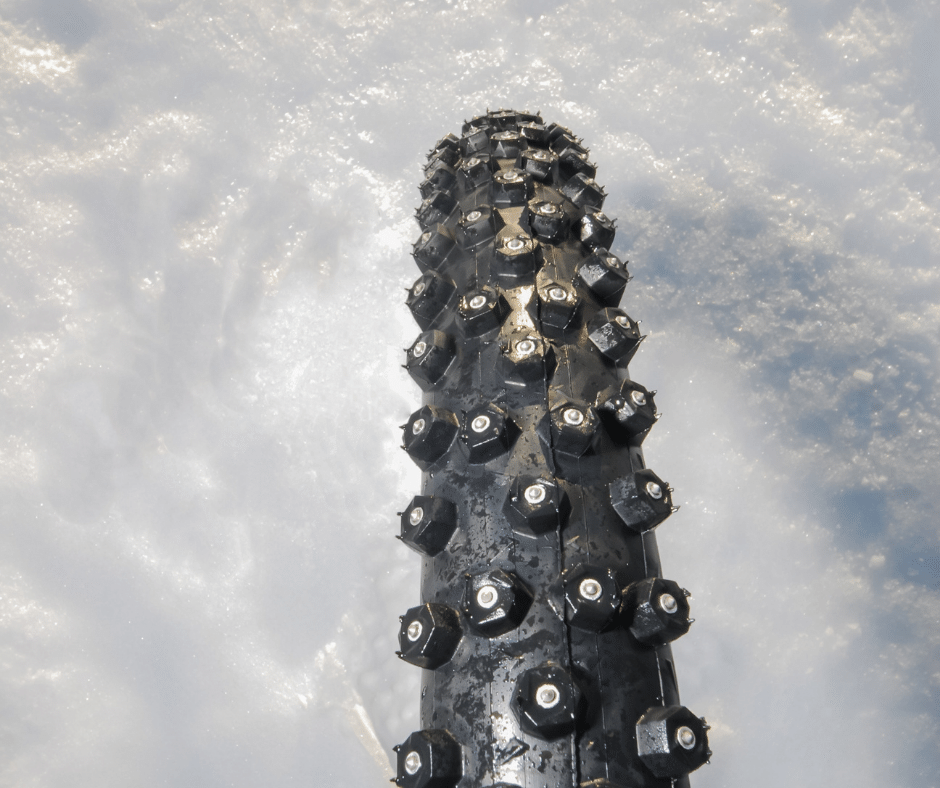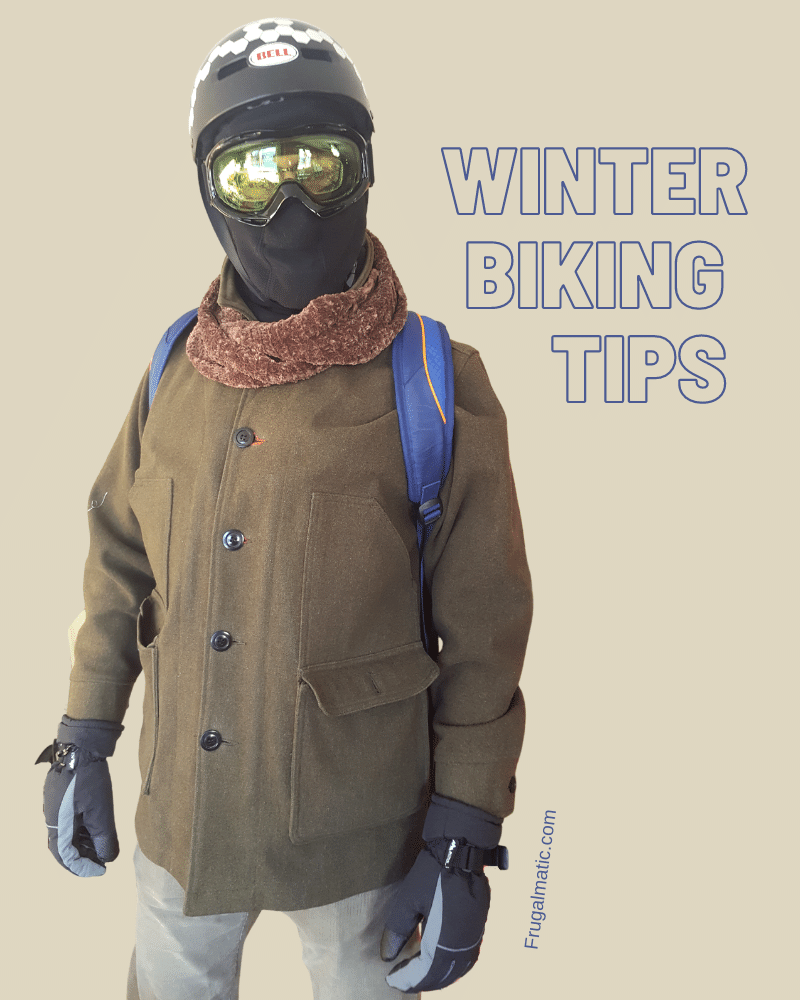This post was last updated on October 19th, 2020 at 03:27 pm
I once allowed the seasons to dictate whether I commuted to work by bike or car. Then about eight years ago, I discovered my winter-riding savior: metal studded tires.
For me, cold wasn’t the problem, at least not the major one. It was ice. The fear of falling kept me from riding in winter for several years. Not until I swapped my regular tires for studded ones did I become confident enough to travel ice-spotted roads, with hundreds of little metal studs keeping my wheels from slipping out from underneath me.
Over the past eight years, I’ve had a couple close calls, but I’ve never crashed in the winter. In fact, I’ve had my worst scrapes in the summer.
Winter riding isn’t for everyone, but I think more bike commuters could be doing it. I find winter bike commuting invigorating, especially while biking through snow storms. This winter, I’ll have to get creative and find new reasons to bike because my new schedule has me working from home.
Designate a winter bike
I recommend you keep one bike for only winter riding—preferably a junker—because the road salt can be brutal on the chain and frame. My winter “cruiser” is a 15-year-old Gary Fisher mountain bike.
You definitely don’t want to subject your prized cycle to winter roads. Plus, having a winter-only bike will allow you to keep the studded tires on it year-round.
On the snowiest weeks, I sometimes oil my bike chain once a day because of the salt’s corrosive effect. The salt is also tough on the brakes. For this reason, I recommend using a bike with rim brakes instead of disc brakes. Disc brake rotors can rust, and it’s more difficult to keep a disc brake caliper clean than a rim brake caliper.
You don’t need a fat-tire bike
I want to also address the growing popularity of fat-tire winter bikes. These are best suited for trail riding, not road travel. Unless you commute to work on a trail, I wouldn’t recommend a fat-tire bike. The larger tire provides more surface area for traction, but studded tires should provide all the traction you need. To improve your traction even more, underinflate the tires a bit.

Other winter-riding necessities
Along with a designated winter bike with studded tires, here are a few other must-have pieces of equipment for winter riding:
Head and rear lights. You should have lights for your bike regardless of the season. It’s especially important in the winter, however, with the shorter days. I also use my lights during the day. One thing you’ll notice about winter riding: There aren’t many people doing it, at least not in the Midwest. Drivers aren’t expecting to see bikers in the winter, and so you want to make yourself highly visible. Also, snowbanks decrease visibility, both for you and drivers. During the day, I set my lights to the “strobe” setting to make my presence even more obvious.
Fenders. When the temperature gets just right, ice and snow turn to slush, and your tires will kick it up. Fenders will deflect it.
Reflective decals. Pepper your helmet and bike with these for the same reason you want to use your bike lights.
Reflective ankle bracelet. This piece of reflective equipment is particularly effective because it moves up and down as you pedal, making you stand out.
Skiing goggles. I rode for years without a pair of these. After I bought a pair, I wondered why I didn’t get them sooner. They keep out the cold wind, and if you wear glasses like I do, you can get goggles to accommodate them.
Balaclava. This face covering leaves only your eyes exposed, making the balaclava ideal for riding in cold conditions.
Gloves and mittens. Make sure you have a high-quality pair to prevent frostbite.
Helmet. It should go without saying that you should wear a helmet for winter riding, but I’m adding it here to go on record.
How to ride in the winter
The old saying about learning to ride a bike is true. Once you know how to ride it, you’ll never forget. But with winter riding, you’ll want to make a few adjustments, particularly on icy roads.
- Take turns slowly and upright. During the summer months, I don’t think twice about leaning into a turn. In the winter—even with studded tires—I take turns slowly. The key is to take the turn as upright as possible so your studded tires don’t slip out from under you. The studs cling nicely to the ice, but they’re not locked to the ice. They can slide if you take a turn sharply.
- Always apply your rear brakes first. That way, if you start to slide, you can still steer your front wheel to regain control. If you use your front brakes first, and your front tire starts to slide, you won’t be able to save yourself with your rear wheel. I’ve almost wiped out a dozen times or so over eight years, but I’ve always been able to regain control by steering the front wheel.
Guard against frostbite
Finally, I’ll touch on the subject of frostbite. Biking in extremely cold weather could leave you vulnerable to frostbite. I’ve never had a problem keeping my body warm while riding because the act of pedaling generates plenty of heat. However, I’ve occasionally felt cold in my fingers and toes. When it’s bitter cold, I make sure to put layers on my hands, and I use mittens instead of gloves so that my fingers stay warmer by being bunched together. I’m grateful I’ve never been frostbitten, and I can’t emphasize enough the importance of dressing appropriately.
Of course, don’t bike when you feel conditions are too dangerous. You just have to use common sense. I can count only a handful of days when it’s been too cold for me to ride. In fact, snow is easier to bike through than rain because you won’t arrive at work all wet. I prefer riding in the snow for that very reason.
A powerful way to stay active
Winter can be a difficult time to build activity into your day, especially because there’s less yard work to do. Winter conditions can last six months or longer in the northern states. To be able to learn how to winter bike greatly expands your activity options. As regular readers of this blog know, I like to fold exercise into my personal responsibilities so that I feel like I’m accomplishing something—not just exercising for the sake of exercising. This is called being frugalmatic.
Once you get into a winter-biking groove (and it may take a little while), it becomes enjoyable. It takes some upfront investment, namely the studded tires, but it’s otherwise a relatively low-cost workout. Are you ready to give winter biking a try? Share this article and let your friends know.

